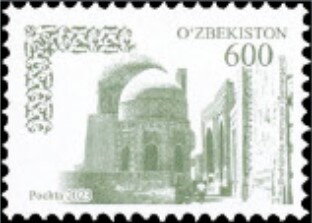Stamp: Shah-i-Zinda Necropolis, Samarkand (Uzbekistan 2023)
Shah-i-Zinda Necropolis, Samarkand (Uzbekistan 2023)
01 May (Uzbekistan ) within release Historical Monuments of Uzbekistan (2022-) goes into circulation Stamp Shah-i-Zinda Necropolis, Samarkand face value 600 Uzbekistani som
| Stamp Shah-i-Zinda Necropolis, Samarkand in catalogues | |
|---|---|
| Yvert et Tellier: | Yt: UZ 1375 |
Stamp is square format.
Also in the issue Historical Monuments of Uzbekistan (2022-):
- Stamp - Islam Ota Mosque, Tashkent face value 5,600;
- Stamp - Shah-i-Zinda Necropolis, Samarkand face value 1,800;
- Stamp - Sherdor Madrasa, Samarkand face value 2,100;
- Stamp - Shah-i-Zinda Necropolis, Samarkand face value 600;
Stamp Shah-i-Zinda Necropolis, Samarkand it reflects the thematic directions:
Architecture (Latin architectura, from the Greek ἀρχιτέκτων arkhitekton "architect", from ἀρχι- "chief" and τέκτων "builder") is both the process and the product of planning, designing, and constructing buildings and other physical structures. Architectural works, in the material form of buildings, are often perceived as cultural symbols and as works of art. Historical civilizations are often identified with their surviving architectural achievements.
A monument is a type of structure that was explicitly created to commemorate a person or event, or which has become relevant to a social group as a part of their remembrance of historic times or cultural heritage, due to its artistic, historical, political, technical or architectural importance. Examples of monuments include statues, (war) memorials, historical buildings, archaeological sites, and cultural assets. If there is a public interest in its preservation, a monument can for example be listed as a UNESCO World Heritage Site. The Palgrave Encyclopedia of Cultural Heritage and Conflict gives the next definition of monument:


